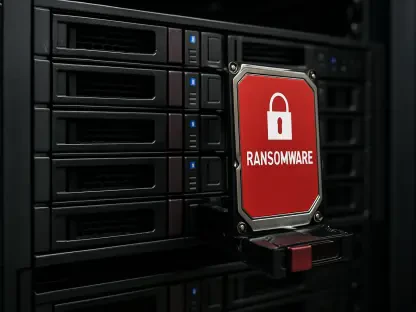In a startling revelation, thousands of organizations worldwide relying on Oracle’s E-Business Suite (EBS) for critical operations have found themselves in the crosshairs of a sophisticated ransomware campaign led by the notorious Cl0p gang. This wave of extortion attacks, exploiting severe vulnerabilities in enterprise software, has sent shockwaves through the cybersecurity community, raising urgent questions about the safety of foundational business systems. With sensitive data at risk and ransom demands piling up, this roundup dives into a collection of opinions, tips, and analyses from various industry sources and experts to uncover why Oracle EBS is under siege, how Cl0p operates, and what steps can safeguard vulnerable systems. The purpose here is to distill diverse perspectives into actionable insights for businesses navigating this escalating crisis.
Unraveling the Oracle EBS Crisis: What Experts Are Saying
The significance of Oracle EBS as a backbone for enterprise resource planning cannot be overstated, yet its current predicament has alarmed security professionals globally. Sources across the industry highlight that a critical flaw in the software’s Concurrent Processing component has become a prime target for cybercriminals. This vulnerability allows remote exploitation without any need for authentication, essentially opening a backdoor to full system compromise. Many experts agree that the scale of potential damage—ranging from data theft to operational shutdowns—demands immediate attention from every organization using this platform.
Differing views emerge on the root causes of such exposure in enterprise software. Some industry watchers point to inherent design complexities in systems like EBS, which, while feature-rich, often lag in security updates due to their intricate architectures. Others argue that the slow adoption of patches by organizations, often due to concerns about operational downtime, exacerbates the problem. A common thread in these discussions is the consensus that this crisis serves as a stark reminder of the fragility of even the most trusted business tools when pitted against determined adversaries.
Breaking Down the Threat: Vulnerability and Cl0p’s Tactics
The Core Flaw: A Gateway for Attackers
At the heart of this storm lies a severe vulnerability, recently patched by Oracle in an emergency rollout, which has left EBS users scrambling to secure their environments. Cybersecurity analysts from various firms describe this flaw as a catastrophic opening, enabling attackers to execute malicious code remotely with no barriers. The urgency of applying the patch has been echoed across multiple channels, with warnings that unpatched systems are essentially sitting ducks for exploitation.
Concerns also linger about the timing of the disclosure and patch release. Some security researchers suggest that the window between vulnerability discovery and public exploit code availability was dangerously short, leaving little room for organizations to react. Others note that even with the patch in place, the risk of prior compromises remains high, urging companies to conduct thorough investigations into past network activity for signs of breach.
A notable divergence in opinion centers on whether patching alone addresses the deeper issue. Certain experts caution that reactive measures fall short against zero-day exploits, advocating for more robust, proactive monitoring to detect intrusions before they escalate. This perspective underscores a broader debate on balancing immediate fixes with long-term security strategies.
Cl0p Ransomware Gang: Precision in Extortion
Turning to the perpetrators, the Cl0p ransomware gang stands out for its calculated approach, often termed “big game hunting” by industry observers. Multiple sources describe Cl0p as a highly strategic group that meticulously selects high-value targets like large enterprises using EBS, aiming to maximize ransom payouts. Their recent campaign, involving extortion emails sent since late last year after initial breaches months prior, showcases a chilling level of organization and patience.
Insights into Cl0p’s methods reveal a blend of technical prowess and psychological pressure. Reports indicate that their communications often include detailed evidence of stolen data, tight deadlines for payment, and even offers of “technical advice” post-ransom to restore systems. While some experts view this as a sign of increasing professionalization in cybercrime, others warn that such tactics heighten the emotional toll on victims, pushing hasty decisions under duress.
Differences arise in assessing Cl0p’s broader impact. A segment of analysts believes their focus on enterprise software signals a shift toward more specialized attacks, potentially inspiring copycat groups. Conversely, others argue that Cl0p’s success hinges on exploiting known gaps in patch management, suggesting that their threat could be mitigated with stricter update protocols across industries.
Exploit Code Fallout: Widening the Danger Zone
The public release of exploit code for the EBS vulnerability has amplified risks, according to a range of cybersecurity voices. This development lowers the entry barrier for less-skilled attackers to launch similar campaigns, potentially leading to a surge in indiscriminate strikes. Alerts from national cybersecurity bodies emphasize the need for heightened vigilance, predicting a wave of attacks in the coming weeks if systems remain unprotected.
Opinions split on the implications of this trend for enterprise software security. Some industry commentators lament that the assumption of inherent safety in such platforms is outdated, given how swiftly vulnerabilities are weaponized post-disclosure. Others stress that the rapid spread of exploit tools reflects a failure in information-sharing mechanisms, where delayed warnings leave defenders perpetually on the back foot.
A recurring recommendation from various sources is the urgent need for network segmentation and reduced internet exposure of critical systems like EBS. While some advocate for legislative measures to curb exploit code distribution, others see this as impractical, instead pushing for better internal preparedness to outpace the speed of malicious innovation.
Oracle’s Response: Timely Action or Missed Opportunities?
Oracle’s reaction to the crisis, including an emergency patch and shared indicators of compromise such as suspicious IP addresses, has drawn mixed feedback from the security community. Many acknowledge the swiftness of the patch rollout as a positive step, especially under intense pressure from ongoing attacks. However, a significant number of analysts critique the lack of detailed transparency about the flaw’s technical nature, arguing it hampers organizations’ ability to fully assess their exposure.
Contrasting views emerge on whether Oracle’s measures suffice in the face of such a sophisticated threat. Some experts suggest that undisclosed related flaws or prior undetected breaches could still pose risks, even to patched systems. Others defend the vendor’s approach, noting that providing too much detail risks aiding attackers, and instead urge companies to complement patches with independent threat hunting.
A broader concern raised by several industry perspectives is the systemic delay in vendor responses to zero-day threats. Critics argue that Oracle, like many large providers, struggles to match the agility of ransomware groups, leaving clients vulnerable during critical windows. This sparks calls for a reevaluation of how software giants communicate and collaborate with users during emergencies.
Key Takeaways from Diverse Perspectives
Synthesizing the insights gathered, several critical points stand out from the collective expertise. The remotely exploitable flaw in Oracle EBS represents a glaring weakness that Cl0p has ruthlessly targeted, using extortion as both a weapon and a business model. The public availability of exploit code has escalated the threat level, inviting more actors into the fray, while Oracle’s emergency response, though prompt, leaves questions about completeness and transparency unanswered.
Practical tips for organizations emerge consistently across sources. Immediate patch application is non-negotiable, coupled with forensic analysis to uncover any past intrusions. Enhancing network defenses, monitoring for indicators of compromise, and minimizing internet-facing exposure of EBS systems are also widely recommended. A proactive stance, including regular threat hunting, is seen as essential to stay ahead of evolving ransomware tactics.
Disparities in opinion highlight areas for deeper exploration, such as the balance between vendor disclosure and security, and the feasibility of preventing exploit code proliferation. These debates underscore that while technical fixes are vital, the human and procedural elements of cybersecurity—training, policy, and readiness—play equally crucial roles in mitigating such crises.
Securing Enterprise Systems: A Collective Call to Action
Reflecting on the discourse surrounding the Oracle EBS attacks, it becomes evident that the cybersecurity landscape faces a pivotal moment with Cl0p’s calculated exploitation. The varied insights from experts and industry bodies paint a picture of urgency, where every delay in response amplifies the damage. The incident has exposed not just technical vulnerabilities, but also gaps in communication and preparedness that need urgent addressing.
Moving forward, organizations should prioritize building layered defenses, integrating real-time monitoring with rapid response protocols to counter sophisticated threats. A push toward greater collaboration between software vendors and users could bridge transparency gaps, ensuring faster, more informed reactions to emerging risks. For those seeking deeper understanding, exploring resources on ransomware mitigation and enterprise software security offers a valuable next step in fortifying against relentless cyber adversaries.









